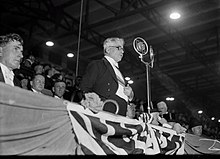
Animal husbandry is the branch of agriculture concerned with animals that are raised for meat, fibre, milk, or other products. It includes day-to-day care, management, production, nutrition, selective breeding, and the raising of livestock. Husbandry has a long history, starting with the Neolithic Revolution when animals were first domesticated, from around 13,000 BC onwards, predating farming of the first crops. By the time of early civilisations such as ancient Egypt, cattle, sheep, goats, and pigs were being raised on farms.
Breed clubs are associations or clubs with activities centered on a single, specific breed of a particular species of domesticated animal. The purpose of the association will vary with the species of animal and the goals and needs of the members of the association. Breed associations or clubs may vary in their goals, activities and nomenclature from country to country, even for the same breed. Most domesticated animals, whether they are agricultural animals such as cattle, llamas, poultry, sheep and pigs, or companion animals such as pigeons, horses, cats and dogs, have breed clubs associated with the breed.
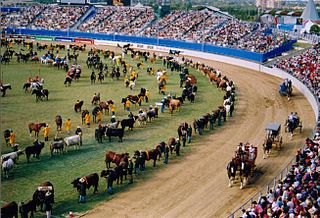
An agricultural show is a public event exhibiting the equipment, animals, sports and recreation associated with agriculture and animal husbandry. The largest comprise a livestock show, a trade fair, competitions, and entertainment. The work and practices of farmers, animal fanciers, cowboys, and zoologists may be displayed. The terms agricultural show and livestock show are synonymous with the North American terms county fair and state fair.
In agriculture and in the hobby of animal fancy, a breeder is an individual animal used for selective breeding. A breeder is usually a purebred animal, bred with the intent of producing purebred, or even show-quality animals. However, in some cases, a breeding animal is crossbred with another breed or a mixed breed with the intent of combining aspects of two or more different breeds.
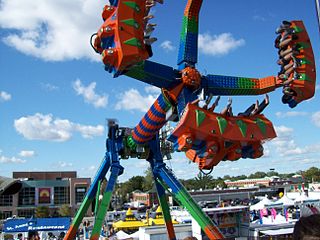
The Western Fair is a fair held annually in London, Ontario, Canada in early September.

Markham Fair is one of Canada's oldest country fairs, an annual event established in 1844. It is located in Markham, Ontario and hosted by the Markham and East York Agricultural Society. With over 700 volunteers working on more than 70 committees, Markham Fair is the largest community-based volunteer organization in Canada. The fair and fairgrounds are owned by the agricultural society.
Ross Butler (1907–1995) was a farmer, photographer, songwriter, livestock judge, cattle and poultry breeder, pioneer of cattle artificial insemination, painter and sculptor of farm animals, as well as a writer.

The Oxford Down is a British breed of domestic sheep. It was developed in the 1830s by cross-breeding of Hampshire Down and Southdown ewes with Cotswold rams. It is reared primarily for meat.
The Harford Fair is a fair held in Harford Township north of Scranton in Susquehanna County, Pennsylvania. It is a traditional country fair that features amusement rides. It also includes livestock judging, chainsaw races, tractor pulls, draft horse and other animal shows. It also includes two selected annual events, such as monster trucks.
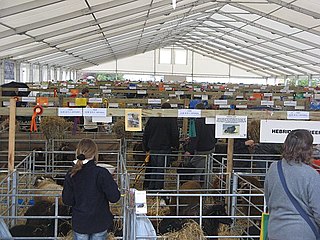
The Royal Highland Show is Scotland's biggest annual Agricultural show. The show is organised by the Royal Highland and Agricultural Society of Scotland.
William Marshal Cleland was a Canadian equestrian champion.

The Paris International Agricultural Show is an annual agricultural show and trade fair, that takes place at the end of February or beginning of March at the Paris expo Porte de Versailles in Paris, France. It is one of the world's largest and most important agricultural shows, drawing larger crowds than any other in Paris except the Foire de Paris.

The Livestock Conservancy, formerly known as the American Livestock Breeds Conservancy (ALBC) and prior to that, the American Minor Breeds Conservancy, is a nonprofit organization focused on preserving and promoting rare breeds, also known as "heritage breeds" of livestock. Founded in 1977, through the efforts of livestock breed enthusiasts concerned about the disappearance of many of the US's heritage livestock breeds, The Livestock Conservancy was the pioneer livestock preservation organization in the United States, and remains a leading organization in that field. It has initiated programs that have saved multiple breeds from extinction, and works closely with similar organizations in other countries, including Rare Breeds Canada. With 3,000 members, a staff of eleven and a 19-member board of directors, the organization has an operating budget of over a million dollars.

The Shetland is a small, wool-producing breed of sheep originating in the Shetland Isles, Scotland, but is now also kept in many other parts of the world. It is part of the Northern European short-tailed sheep group, and it is closely related to the extinct Scottish Dunface. Shetlands are classified as a landrace or "unimproved" breed. This breed is kept for its very fine wool, for meat, and for conservation grazing.

The Hants County Exhibition is an annual fall fair held in Windsor, Nova Scotia. It is known for being the oldest continuously run agricultural fair in North America. It was first held on the grounds of Fort Edward beginning in 1765 and has been running continuously since 1815.The fair has been held at the nearby Hants Exhibition Arena and exhibition grounds since the land was purchased in 1949. September 2015 marked the 250th anniversary of the Hants County Exhibition. Five years later, the fair went virtual because of the COVID-19 pandemic in Canada.
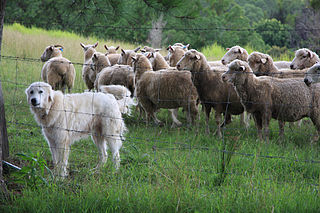
A livestock guardian dog (LGD) is a dog type bred for the purpose of protecting livestock from predators.
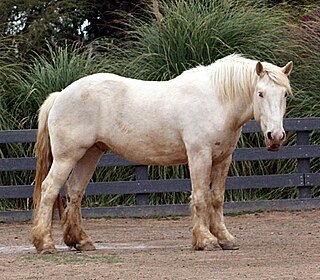
In modern agriculture, a rare breed is a breed of poultry or livestock that has a very small breeding population, usually from a few hundred to a few thousand. Because of their small numbers, rare breeds may have a threatened conservation status, and they may be protected under regional laws. Many countries have organizations devoted to the protection and promotion of rare breeds, for which they each have their own definition. In botany and horticulture, the parallel to rare animal breeds are heirloom plants, which are rare cultivars.

The goat or domestic goat is a species of domesticated goat-antelope that is mostly kept as livestock. It was domesticated from the bezoar ibex of Southwest Asia and Eastern Europe. The goat is a member of the family Bovidae, meaning it is closely related to the sheep. There are over 300 distinct breeds of goat. It is one of the oldest domesticated species of animal, according to archaeological evidence that its earliest domestication occurred in Iran at 10,000 calibrated calendar years ago.
Joseph Yuill was a Canadian farmer and educator.

